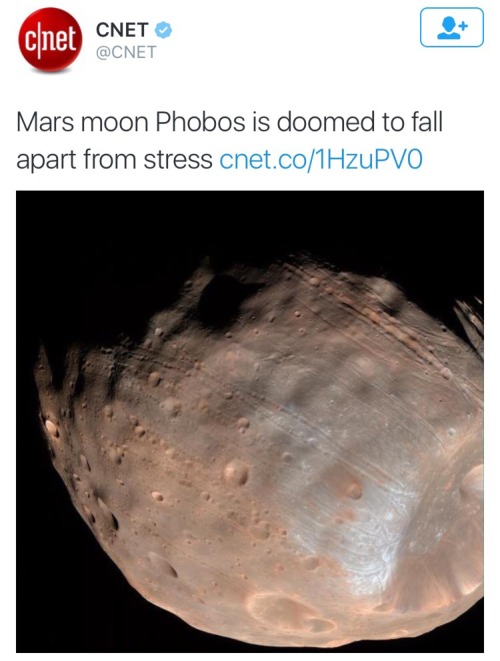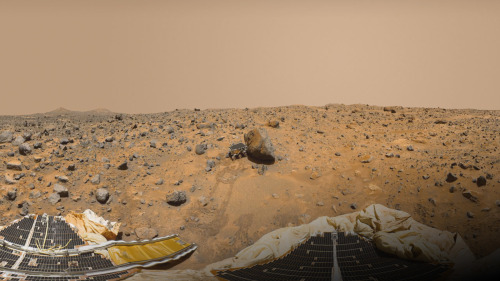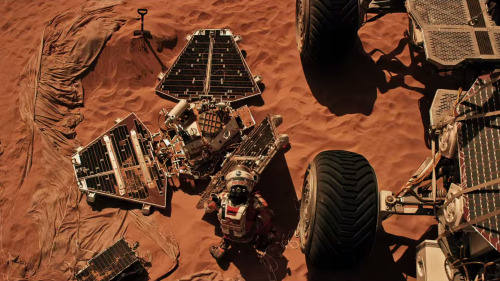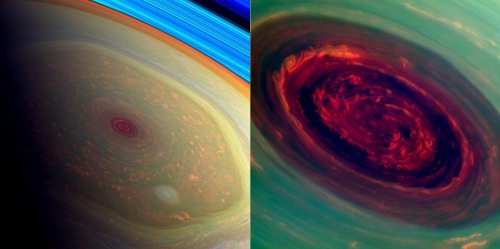Wow Me Too

Wow me too
More Posts from Intergalacticnerd and Others

Gravitational Waves.


Mars Pathfinder & Sojourner Rover (360 View) Explained
Thanks to new technology, we can take a 360-degree tour of the 1997 Pathfinder mission landing site, including Sojourner, the first Mars rover. Check out this interactive YouTube panorama, and then…
…keep scrolling to find out more about each point of interest, how the Pathfinder mission compares to “The Martian” and NASA’s real Journey to Mars.

Yogi
“Yogi” is a meter-size rock about 5 meters northwest of the Mars Pathfinder lander and the second rock visited by the Sojourner Rover’s alpha proton X-ray spectrometer (APXS) instrument. This mosaic shows super resolution techniques applied to help to address questions about the texture of this rock and what it might tell us about how it came to be.

Twin Peaks
The Twin Peaks are modest-size hills to the southwest of the Mars Pathfinder landing site. They were discovered on the first panoramas taken by the IMP camera on the July 4, 1997, and subsequently identified in Viking Orbiter images taken over 20 years ago. They’re about 30-35 meters tall.

Barnacle Bill
“Barnacle Bill” is a small rock immediately west-northwest of the Mars Pathfinder lander and was the first rock visited by the Sojourner Rover’s alpha proton X-ray spectrometer (APXS) instrument. If you have some old-school red-cyan glasses, put them on and see this pic in eye-popping 3-D.

Rock Garden
The Rock Garden is a cluster of large, angular rocks tilted in a downstream direction from ancient floods on Mars. The rocky surface is comprised of materials washed down from the highlands and deposited in this ancient outflow channel.

MOAR INFO
Pathfinder Lander & Sojourner Rover
Mission Facts [PDF]
Science Results
Rock & Soil Types


This vista was stitched together from many images taken in 1997 by Pathfinder.

Pathfinder and Sojourner figure into Mark Watney’s quest for survival on the Red Planet in the book and movie, “The Martian.” See JPL’s role in making “The Martian” a reality: http://go.nasa.gov/1McRrXw and discover nine real NASA technologies depicted in “The Martian”: http://go.nasa.gov/1QiyUiC.

So what about the real-life “Journey to Mars”? NASA is developing the capabilities needed to send humans to Mars in the 2030s. Discover more at http://nasa.gov/journeytomars and don’t forget to visit me when you make it to the Red Planet. Until then, stay curious and I’ll see you online.









“We used to look up at the sky and wonder at our place in the stars. Now we just look down, and worry about our place in the dirt.”

Saturn’s hexagonal storm system in it’s north pole
tell the moon i love her
Dear moon, @324b2dun loves you. Happy Valentines!


The Shakespearean Moons of Uranus
This weekend marks the 400th anniversary of Shakespeare’s death, and we’re highlighting the moons of Uranus; some of which are named after characters from his works.

While most of the moons orbiting other planets take their names from Greek mythology, Uranus’ moons are unique in bing named for Shakespearean characters, along with a couple of them being named for characters from the works of Alexander Pope.

Using the Hubble Space Telescope and improved ground-based telescopes, astronomers have discovered a total of 27 known moons around Uranus.
Here’s a sampling of some of the unique aspects of the moons:
Miranda

Shakespearean work: The Tempest
Miranda, the innermost and smallest of the five major satellites, has a surface unlike any other moon that’s been seen. It has a giant fault canyon as much as 12 times as deep as the Grand Canyon, terraced layers and surfaces that appear very old, and others that look much younger.
Ariel

Shakespearean work: The Tempest
Ariel has the brightest and possibly the youngest surface among all the moons of Uranus. It has a few large craters and many small ones, indicating that fairly recent low-impact collisions wiped out the large craters that would have been left by much earlier, bigger strikes. Intersecting valleys pitted with craters scars its surface.
Oberon

Shakespearean work: A Midsummer Night’s Dream
Oberon, the outermost of the five major moons, is old, heavily cratered and shows little signs of internal activity. Unidentified dark material appears on the floors of many of its craters.
Cordelia and Ophelia

Shakespearean works: Cordelia - King Lear; Ophelia - Hamlet
Cordelia and Ophelia are shepherd moons that keep Uranus’ thin, outermost “epsilon” ring well defined.
Between them and miranda is a swarm of eight small satellites unlike any other system of planetary moons. This region is so crowded that astronomers don’t yet understand how the little moons have managed to avoid crashing into each other. They may be shepherds for the planet’s 10 narrow rings, and scientists think there must be still more moons, interior to any known, to confine the edges of the inner rings.
Want to learn more about all of Uranus’s moons? Visit: http://solarsystem.nasa.gov/planets/uranus/moons
Check out THIS blog from our Chief Scientist Ellen Stofan, where she reflects on the life and legacy of William Shakespeare on the 400th anniversary of his death on April 23, 1616.
Make sure to follow us on Tumblr for your regular dose of space: http://nasa.tumblr.com
Views of Pluto
10 Images to Celebrate the Historic Exploration of the Pluto System
One year ago, our New Horizons mission made history by exploring Pluto and its moons – giving humankind our first close-up look at this fascinating world on the frontier of our solar system.

Since those amazing days in July 2015, the New Horizons spacecraft has transmitted numerous images and many other kinds of data home for scientists and the public alike to study, analyze, and just plain love. From Pluto’s iconic “heart” and sweeping ice-mountain vistas to its flowing glaciers and dramatic blue skies, it’s hard to pick just one favorite picture. So the mission team has picked 10 – and in no special order, placed them here.
Click the titles for more information about each image. You’ve seen nine of them before, and the team added a 10th favorite, also sure to become one of New Horizons’ “greatest hits.”
Vast Glacial Flows

In the northern region of Pluto’s Sputnik Planum, swirl-shaped patterns of light and dark suggest that a surface layer of exotic ices has flowed around obstacles and into depressions, much like glaciers on Earth.
Jagged Ice Shorelines and Snowy Pits

This dramatic image from our New Horizons spacecraft shows the dark, rugged highlands known as Krun Macula (lower right), which border a section of Pluto’s icy plains.
Blue Skies

Pluto’s haze layer shows its blue color in this picture taken by the New Horizons Ralph/Multispectral Visible Imaging Camera (MVIC). The high-altitude haze is thought to be similar in nature to that seen at Saturn’s moon Titan.
Charon Becomes a Real World

At half the diameter of Pluto, Charon is the largest satellite relative to its planet in the solar system. Many New Horizons scientists expected Charon to be a monotonous, crater-battered world; instead, they’re finding a landscape covered with mountains, canyons, landslides, surface-color variations and more.
The Vistas of Pluto

Our New Horizons spacecraft looked back toward the sun and captured this near-sunset view of the rugged, icy mountains and flat ice plains extending to Pluto’s horizon. The backlighting highlights over a dozen layers of haze in Pluto’s tenuous but distended atmosphere.
The Dynamic Duo: Pluto and Charon in Enhanced Color

The color and brightness of both Pluto and Charon have been processed identically to allow direct comparison of their surface properties, and to highlight the similarity between Charon’s polar red terrain and Pluto’s equatorial red terrain. Pluto and Charon are shown with approximately correct relative sizes, but their true separation is not to scale.
Strange Snakeskin Terrain

A moment’s study reveals surface features that appear to be texturally ‘snakeskin’-like, owing to their north-south oriented scaly raised relief. A digital elevation model created by the New Horizons’ geology shows that these bladed structures have typical relief of about 550 yards (500 meters). Their relative spacing of about 3-5 kilometers makes them some of the steepest features seen on Pluto.
Pluto’s Heart

This view is dominated by the large, bright feature informally named the “heart,” which measures approximately 1,000 miles (1,600 kilometers) across. The heart borders darker equatorial terrains, and the mottled terrain to its east (right) are complex. However, even at this resolution, much of the heart’s interior appears remarkably featureless—possibly a sign of ongoing geologic processes.
Far Away Snow-Capped Mountains

One of Pluto’s most identifiable features, Cthulhu (pronounced kuh-THU-lu) stretches nearly halfway around Pluto’s equator, starting from the west of the great nitrogen ice plains known as Sputnik Planum. Measuring approximately 1,850 miles (3,000 kilometers) long and 450 miles (750 kilometers) wide, Cthulhu is a bit larger than the state of Alaska.
Colorful Composition Maps of Pluto

The powerful instruments on New Horizons not only gave scientists insight on what Pluto looked like, their data also confirmed (or, in many cases, dispelled) their ideas of what Pluto was made of. These compositional maps – assembled using data from the Linear Etalon Imaging Spectral Array (LEISA) component of the Ralph instrument – indicate the regions rich in ices of methane (CH4), nitrogen (N2) and carbon monoxide (CO), and, of course, water ice (H2O).
Make sure to follow us on Tumblr for your regular dose of space: http://nasa.tumblr.com
-
 rowdyrowboat reblogged this · 3 months ago
rowdyrowboat reblogged this · 3 months ago -
 smellslikebutz liked this · 4 months ago
smellslikebutz liked this · 4 months ago -
 theoristbeliever liked this · 4 months ago
theoristbeliever liked this · 4 months ago -
 spoopyandtired reblogged this · 4 months ago
spoopyandtired reblogged this · 4 months ago -
 spoopyandtired liked this · 4 months ago
spoopyandtired liked this · 4 months ago -
 infamousbicat liked this · 4 months ago
infamousbicat liked this · 4 months ago -
 littlemoondarling reblogged this · 4 months ago
littlemoondarling reblogged this · 4 months ago -
 littlemoondarling reblogged this · 4 months ago
littlemoondarling reblogged this · 4 months ago -
 littlemoondarling liked this · 4 months ago
littlemoondarling liked this · 4 months ago -
 kakzendingen reblogged this · 4 months ago
kakzendingen reblogged this · 4 months ago -
 kakzendingen liked this · 4 months ago
kakzendingen liked this · 4 months ago -
 kira-quartz liked this · 8 months ago
kira-quartz liked this · 8 months ago -
 gamelpar liked this · 8 months ago
gamelpar liked this · 8 months ago -
 causereyna-artie liked this · 1 year ago
causereyna-artie liked this · 1 year ago -
 idk-what-to-put-here-123 reblogged this · 1 year ago
idk-what-to-put-here-123 reblogged this · 1 year ago -
 good-oldfashioned-lover-girl reblogged this · 1 year ago
good-oldfashioned-lover-girl reblogged this · 1 year ago -
 delicatemoonishlyfrogx reblogged this · 1 year ago
delicatemoonishlyfrogx reblogged this · 1 year ago -
 boowoomuu reblogged this · 1 year ago
boowoomuu reblogged this · 1 year ago -
 boowoomuu liked this · 1 year ago
boowoomuu liked this · 1 year ago -
 somethinggotoutofthepaintings reblogged this · 1 year ago
somethinggotoutofthepaintings reblogged this · 1 year ago -
 cheahup liked this · 1 year ago
cheahup liked this · 1 year ago -
 saphicspacesociety19 reblogged this · 1 year ago
saphicspacesociety19 reblogged this · 1 year ago -
 folklore-fantasy-and-sci-fi liked this · 1 year ago
folklore-fantasy-and-sci-fi liked this · 1 year ago -
 joypics liked this · 1 year ago
joypics liked this · 1 year ago -
 regal-fish liked this · 1 year ago
regal-fish liked this · 1 year ago -
 calkosuaki liked this · 1 year ago
calkosuaki liked this · 1 year ago -
 abatonandouro reblogged this · 1 year ago
abatonandouro reblogged this · 1 year ago -
 raven-6-10 liked this · 1 year ago
raven-6-10 liked this · 1 year ago -
 wernher-von-brawny reblogged this · 1 year ago
wernher-von-brawny reblogged this · 1 year ago -
 m0mmadollarubbahubba reblogged this · 1 year ago
m0mmadollarubbahubba reblogged this · 1 year ago -
 m0mmadollarubbahubba liked this · 1 year ago
m0mmadollarubbahubba liked this · 1 year ago -
 kosiusfs liked this · 2 years ago
kosiusfs liked this · 2 years ago -
 blingxblang liked this · 2 years ago
blingxblang liked this · 2 years ago -
 missxdelaneyart liked this · 2 years ago
missxdelaneyart liked this · 2 years ago -
 deactivated-posts reblogged this · 2 years ago
deactivated-posts reblogged this · 2 years ago
"Astronomy compels the soul to look upwards and leads us from this world to another." - Plato
147 posts
